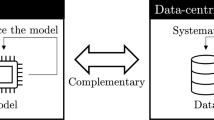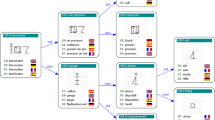Abstract
Nowadays, artificial intelligence (AI) algorithms are being designed, exploited and integrated into a wide variety of software or systems for different and heterogenous application domains. AI is definitively and progressively emerging as transversal and powerful technological paradigm, due to its ability not only to deal with big data and information, but especially because it produces, manages and exploits knowledge. Researchers and scientists are starting to explore, from several perspectives, the different and synergetic ways AI will transform heterogenous business models and every segment of all industries.
Just as electricity transformed almost everything 100 years ago, today I actually have a hard time thinking of an industry that I don’t think AI will transform in the next several years. —Andrew Ng
Access this chapter
Tax calculation will be finalised at checkout
Purchases are for personal use only
Similar content being viewed by others
References
M.S. Abdullah, C. Kimble, I. Benest, R. Paige, Knowledge-based systems: a re-evaluation. J. Knowl. Manag. 10(3), 127–142 (2006). https://doi.org/10.1108/13673270610670902
A. Agrawal, J. Gans, A. Goldfarb, in Prediction machines: the simple economics of artificial intelligence (Harvard Business Press, 2018)
R. Akerkar, P. Sajja, Knowledge-Based Systems (Jones & Bartlett Publishers Inc., USA, 2009)
R.J. Amineh, H.D. Asl, Review of constructivism and social constructivism. J. Soc. Sci. Literat. Languages 1(1), 9–16 (2015)
E. Brynjolfsson, A.N.D.R.E.W. Mcafee, Artificial intelligence, for real. Harv. Bus. Rev. 1, 1–31 (2017)
K. Butler, Connectionism, classical cognitivism and the relation between cognitive and implementational levels of analysis. Philos. Psychol. 6(3), 321–333 (1993). https://doi.org/10.1080/09515089308573095
D. Fasko Jr., An analysis of multiple intelligences theory and its use with the gifted and talented. Roeper Rev. 23(3), 126–130 (2001)
N. Fleming, How artificial intelligence is changing drug discovery. Nature 557(7706), S55–S55 (2018)
J.A. Fodor, Precis of the modularity of mind. Behav. Brain Sci. 8(1), 1–5 (1985)
C.B. Frey, M.A. Osborne, The future of employment: how susceptible are jobs to computerisation? Technol. Forecast. Soc. Chang. 114, 254–280 (2017)
A. Garnham, Cognitivism. in The Routledge Companion to Philosophy of Psychology (Routledge, 2019), pp. 99–110
Gartner, Gartner top 10 strategic technology trends for 2020. Gartner (2021). https://www.gartner.com/en/information-technology/insights/top-technology-trends. Last Accessed 14 Aug 2022
L. Gunderson, L.S. Siegel, The evils of the use of IQ tests to define learning disabilities in first-and second-language learners. Read. Teach. 55(1), 48–55 (2001)
N. Haefner, J. Wincent, V. Parida, O. Gassmann, Artificial intelligence and innovation management: a review, framework, and research agenda✰. Technol. Forecast. Soc. Chang. 162, 120392 (2021)
F. Van Harmelen, V. Lifschitz, B. Porter (Eds.), in Handbook of knowledge representation, vol 2 (Elsevier, 2008), pp. 1–1006
IDC, Worldwide semiannual artificial intelligence tracker (International Data Corporation, 2022)
L. James, L. James, S. Stuart, N. Roger, L.H. Christopher, Artificial intelligence: a general survey (Science Research Council, 1973)
S. Ji, S. Pan, E. Cambria, P. Marttinen, S.Y. Philip, A survey on knowledge graphs: representation, acquisition, and applications. IEEE Trans. Neural Netw. Learn. Syst. 33(2), 494–514 (2021)
C.G. Langton, Studying artificial life with cellular automata. Physica D 22(1–3), 120–149 (1986)
Weng et al., Autonomous mental development by robots and animals. Science 291, 599–600 (2001)
J. Launchbury, A DARPA perspective on artificial intelligence. Technica Curiosa (2017). Online URL: https://machinelearning.technicacuriosa.com/2017/03/19/a-darpa-perspective-on-artificial-intelligence/. Last Accessed 14 Aug 2022
J. Lee, T. Suh, D. Roy, M. Baucus, Emerging technology and business model innovation: the case of artificial intelligence. J. Open Innov.: Technol. Market and Complexity 5(3), 44 (2019)
Y.G. Lyu, Artificial intelligence: enabling technology to empower society. Engineering 6(3), 205–206 (2020)
B. Marr, Artificial Intelligence in Practice: How 50 Successful Companies Used AI and Machine Learning to Solve Problems (Wiley, 2019)
J. McCarthy, M.L. Minsky, N. Rochester, C.E. Shannon, A proposal for the dartmouth summer research project on artificial intelligence, august 31, 1955. AI Mag. 27(4), 12–12 (2006)
P. McLeod, K. Plunkett, E.T. Rolls, Introduction to Connectionist Modelling of Cognitive Processes (Oxford University Press, 1998)
A. Newell, J.C. Shaw, H.A. Simon, Report on a general problem sol[ving program. in IFIP Congress, June, vol 256 (1959), pp. 64
F. Rosenblatt, The perceptron: a probabilistic model for information storage and organization in the brain. Psychol. Rev. 65(6), 386 (1958)
P. Salovey, J.D. Mayer, Emotional intelligence. Imagin. Cogn. Pers. 9(3), 185–211 (1990)
M. San Miguel, J.H. Johnson, J. Kertesz, K. Kaski, A. Díaz-Guilera, R.S. MacKay, D. Helbing, Challenges in complex systems science. The Europ. Phys. J. Special Topics 214(1), 245–271 (2012)
K. Schwab, in The fourth industrial revolution. Currency (2017)
S. Shanmuganathan, Artificial neural network modelling: an introduction. in Artificial Neural Network Modelling. Studies in Computational Intelligence, ed. by S. Shanmuganathan, S. Samarasinghe, vol 628. (Springer, Cham, 2016). https://doi.org/10.1007/978-3-319-28495-8_1
Statista, Revenues from the artificial intelligence (AI) market worldwide from 2018 to 2025. Statista (2022)
G. Von Krogh, Artificial intelligence in organizations: new opportunities for phenomenon-based theorizing. Acad. Managem. Discoveries 4, 404–409 (2018)
H. Wang, B. Raj, On the origin of deep learning (2017). arXiv preprint arXiv:1702.07800
J. Weizenbaum, ELIZA—a computer program for the study of natural language communication between man and machine. Commun. ACM 9(1), 36–45 (1966)
K. Westcott Grant, Netflix's data-driven strategy strengthens claim for ‘best original content’ In 2018. Forbes (2018). https://www.forbes.com/sites/kristinwestcottgrant/2018/05/28/netflixs-data-driven-strategy-strengthens-lead-for-best-original-content-in-2018/?sh=8f21fc13a94e. Last Accessed 14 Aug 2022
World Economic Forum, The future of jobs 2017. (World Economic Forum, 2017)
J. Zhang, B. Chen, L. Zhang, X. Ke, H. Ding, Neural, symbolic and neural-symbolic reasoning on knowledge graphs. AI Open 2, 14–35 (2021)
M. Ziegler, E. Danay, M. Heene, J. Asendorpf, M. Bühner, Openness, fluid intelligence, and crystallized intelligence: toward an integrative model. J. Res. Pers. 46(2), 173–183 (2012)
Author information
Authors and Affiliations
Corresponding author
Editor information
Editors and Affiliations
Rights and permissions
Copyright information
© 2023 The Author(s), under exclusive license to Springer Nature Switzerland AG
About this chapter
Cite this chapter
Marconi, L. (2023). AI, the Overall Picture. In: Cecconi, F. (eds) AI in the Financial Markets . Computational Social Sciences. Springer, Cham. https://doi.org/10.1007/978-3-031-26518-1_2
Download citation
DOI: https://doi.org/10.1007/978-3-031-26518-1_2
Published:
Publisher Name: Springer, Cham
Print ISBN: 978-3-031-26517-4
Online ISBN: 978-3-031-26518-1
eBook Packages: Computer ScienceComputer Science (R0)




